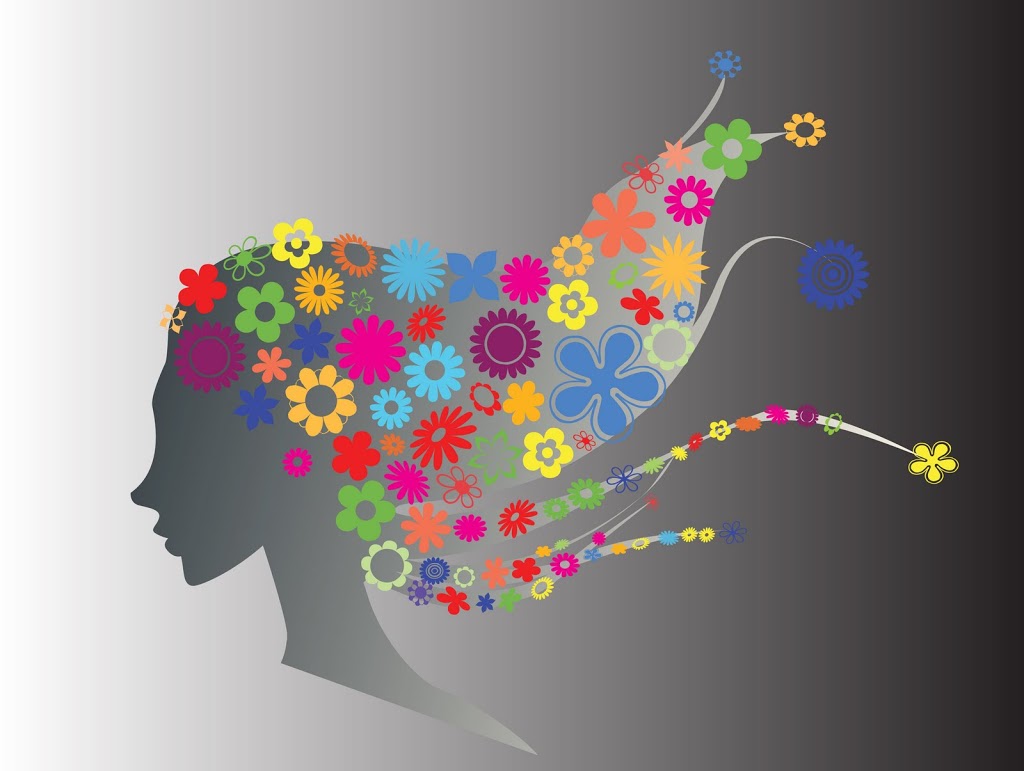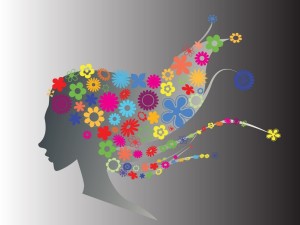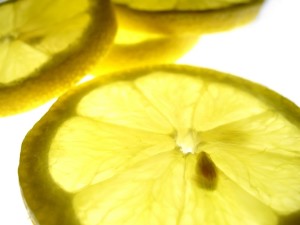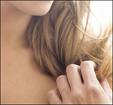
by theglamscientist | | hair, hair care, hair conditioning, hair damage, hair elasticity, healthy hair |

Elasticity is a very important factor in assessing the strength of hair. The elasticity of the hair is an indicator of what styles and/or processes your hair can withstand. When hair has low elasticity, it will not hold a curl well (thermal or wet styled) and it is more prone to damage caused by styling and chemical treatments. Basically, hair with low elasticity is weak and must be handled with care.
Chemical treatments including relaxers, permanent wave, color and even keratin should be preceded by an elasticity strand test to ensure minimal (ideally zero) breakage occurs. But you should also consider performing an elasticity test before going to wacky with the hooded dryer, blow dryer, round brush and flat iron because this requires good elasticity, too. One way to test your hair’s elasticity is to take a [full length] strand of hair from your comb or brush. Hold the strand with the index finger and thumb of both hands about 2 inches apart. Quickly and firmly pull the strand of hair. If the strand snaps, it has low elasticity; If it remains in tack, it has good elasticity.
Another strand test that is equally as fun is what I call the “ribbon curl” test. Hold a strand of hair between the index finger and thumb of one hand. With the index finger and thumb of the opposite hand, use your thumb nail to firmly run along the length of the strand so that it curls. — This is similar to curling a ribbon with scissors. — Now stretch the curl until the strand is straight then let it go. If the strand returns to the original curl pattern, it has good elasticity. If it returns to at least half the original curl, it has moderate elasticity. If it stays straight, your hair is in bad shape :(.
Many factors affect the elasticity of the hair. Excessive heat styling, combing/brushing when the hair is wet and chemical treatments can all have a devastating effect on your hair’s level of elasticity. If after performing the strand test you find that your hair has low elasticity, avoid all of the above styling faux pas. Hair elasticity can be improved by giving your hair what it lacks… PROTEIN! Hair is 100% protein (keratin). Hair with low elasticity has weaker protein bonds than that of good elasticity. Nevertheless protein treatments are a good idea for everyone sooooo… Run, run, run to your nearest beauty supply to purchase a deep conditioning protein treatment.
Here’s to the Glam Life!

by theglamscientist | | acidic, alkaline, basic, conditioner, hair, hair care, healthy hair, pH balance, pH test, shampoo |

I started a new project in the lab last week that inspired this blog post. While developing new products, a lot of “tests” are done to make sure all is as it should be. One test that is a constant for all (most) products is pH. pH indicates the level of acidity (or basicity pOH) of a substance. pH is important in cosmetic product development because skin and hair have pH too. The products you apply to your skin and hair should work with your body chemistry, not against it.
The pH scale starts at 0 and caps off at 14 with 0 being highly acidic, 14 being highly basic and 7 being neutral (7 is the pH of distilled water). Either end of the scale results in severe chemical burns. The pH of normal, healthy hair ranges from 4.5 to 5.5 (mildly acidic). Similarly, the pH of basic hair care products range between 4 and 6. Color treated and/or damaged hair tends to have a more basic (alkaline) pH. In a basic environment, the cuticle layer of the hair stands out and appears frayed or split. In order to treat damaged hair, a hair product must be more acidic to smooth the cuticle layer resulting in less tangles and higher shine. The process of treating alkaline hair with acidic products is what is meant by “pH balanced”. Knowing that damaged hair has a higher pH indicates that a normal pH hair care product may not be very effective in treating damaged hair.
Putting it all together
I’m sure you’ve noticed that hair care products are marketed for certain hair types ie dry/damaged/split ends, normal, oily, etc. While these products will often use different ingredients to garner results, one key factor is pH. A formulator will know if the product has a chance of working just by taking the pH of the final formula. I have rarely seen the pH of a hair care product disclosed on the packaging. So as the consumer, you need to get a little crafty. Before trying a product, I suggest you pick up your own supply of pH (litmus) paper and do a quick test. The ideal pH would be 4 or 4.5 to work well on all hair types. No matter how damaged your hair may appear, you never want a product with a pH lower than 3– and even that’s pushing it. **Keep in mind, the pH test only works for products/treatments that contain water.
You’re now just a pH test away from gorgeous, healthy hair 😉 Here’s to the Glam Life!
by theglamscientist | | hair care, hair cycle, hair growth |

In order to maximize your personal hair growth cycle, you should implement a consistent hair care routine. This post is just my suggestion; the technique I use to ensure my hair is as healthy as possible. Remember healthy hair is key to getting your hair to its longest length. Alter this technique so that it suits your particular needs.
Wash your hair often (at least once a week) with a good quality moisturizing shampoo followed by moisturizing conditioner. Remember to steer clear of alcohols which are very drying to the scalp and hair. Greasy hair needs to be washed more often than dryer, curly hair. **Dirty hair does not grow faster than clean hair. That’s just nasty! Avoid 2 in 1 products; their conditioning is rarely as effective as a stand alone conditioner. For softer hair, do not rinse away all the conditioner. Leaving a trace of conditioner on the hair helps to smooth the cuticle layer and provides a layer of protection until the next wash. Once a month, I recommend a deep conditioner. Leave it on for no less than 10-15 minutes, but really what’s the rush? Relax, watch a movie, read a book.
As previously discussed, regular trims are essential to ensure the hair on your hair is its healthiest. I usually get my ends trimmed with every relaxer treatment. For me that is every 4 weeks. Most stylists recommend a trim every six to eight weeks. Just be mindful of how your ends look. If they are frizzy, dry or transparent, its definitely time for a trim.
Since heat is not a friend to our hair, keep heat styling to a minimum. Blow dry your hair and then heat style as desired ONCE A WEEK. Use a light hair oil or a thermal styling product to help protect your hair from heat damage. Do not pick up a flat iron, curling iron, crimping iron, etc again until the next wash. You’ll be surprised how much you reduce split ends and breakage just following this one rule.
There is a lot of pressure to go natural these days. If you feel the urge, look for products with botanicals, herbs and minerals in the ingredients. Such products will provide many nutrients that the body does not produce on its own. You can get the same benefits of natural hair care by altering your diet to include the foods discussed in “The Friend”. When making the switch from mainstream hair products to all natural hair products, the condition of your hair may appear to get worse before it gets better. This phenomenon is similar to an addict in recovery, the hair goes through a withdrawal period.
One last note, chemically treated hair needs extra TLC. If your hair is permanently colored, bleached, permed or relaxed, you should consider using a deep conditioner with each wash and adding a hot oil treatment once a month. You may also find that you need to get your ends trimmed more regularly. To one and all– go easy on the styling products. Product buildup is definitely “The Enemy”.
Here’s to the Glam Life and Long, Luxurious Hair!
by theglamscientist | | hair care, hair damage, hair growth, health food, humectant |
In the previous posts for the Long, Luxurious Hair Series, we discussed the science behind hair growth and factors that negatively affect the growth process. Armed with that information, we are now able to investigate ways to optimize individual hair growth cycles. The key is to protect the hair from extensive damage and breakage.
The very best way to promote healthy hair growth is from the inside out. Incorporating foods that aid in hair growth and strength is a healthy and safe way to reach the ultimate goal. Hair is made primarily of a strong protein called keratin which is also found in skin and nails. Variations in the amino acids found in keratin account for the differences in texture with some being soft and/flexible and some being hard. Since hair is made of protein, eating foods that are high in protein will be beneficial to the condition of the hair. Iron, B Vitamins, Essential Fatty Acids, Vitamin E and sulfur are also good additions to a healthy hair diet. Adding more of the following foods will be a good start: fish, eggs, leafy green vegetables, yogurt and nuts. Experimenting with different recipes that include these foods is a fun way to change your diet. Stear clear of hair growth supplements, they are potentially dangerous and unnecessary.
Aside from altering your eating habits, there are some topical hair treatments that will help to repair and prevent damage. Moisture is a must for healthy hair. Dry hair is often brittle and easily broken. It is important to note that hair oil products are not moisturizing products. Good moisturizing products will infuse moisture (water) in the hair shaft which hydrates the cuticle layer helping to create shine and prevent breakage and/or split ends. Use shampoos and conditioners that have humectants in the ingredients list. Humectants draw moisture to the hair and hold it there. Some humectants are glycerin, honey, sugar cane, hydrolyzed wheat starch, sodium PCA, panthenol, sorbitol, propylene glycol, butylene glycol and acetamide MEA. Also be sure to avoid of sulfates and alcohol which strip the hair of its natural oils.
Heat styling can cause damage to the hair shaft when used in excess. In addition to minimizing the use of heat, you should invest in thermal styling hair products which help to protect the hair from permanent damage and usually have other nutritive properties.
Finally, having your ends trimmed on a regular basis is your hair’s very best friend. Split ends are not only unsightly, but they spread. Ragged ends easily get tangled with other strands of hair and cause breakage when the hair is combed or brushed. Uncontrolled split ends continue to split, higher and higher up the hair shaft causing frizzy, dry, damaged looking hair. When this sort of damage is finally addressed, the hair has to be cut much more than it would had it been dealt with early. Most stylists recommend a scheduled trim every six weeks.
In the final post of the series, we will discuss a technique to maintaining healthy hair for optimal hair growth.
by theglamscientist | | hair care, hair damage, hair growth, hair relaxer |

Before I begin discussing “The Enemy”, I’d like to give a brief and blunt recap of Part I. Simply put, a person’s hair will grow only to the length that their individual growth cycle allows. There is no product or technique that will extend your unique hair growth cycle. That being said, healthy hair should be the ultimate goal. The result of improperly cared for hair is breakage. Naturally breakage abbreviates the potential length of your hair. There are several culprits which negatively affect the hair growth cycle. Included are heat, chemicals and styling products. Here’s why:
The most key fact in understanding “The Enemy” is knowing that by the time the hair emerges from the scalp, it is no longer alive. Consider a fresh flower arrangement. Once the flowers are cut, they are no longer receiving a continual supply of the nutrients needed to survive. As the recipient of the flowers, we do all we can to keep the flowers in bloom for as long as possible. We clip the stems at just the right angle, put them in water, add plant food, prune the leaves, etc. Similarly, our hair needs just as much TLC.
Heat styling can be both beneficial and counter-productive. The benefits will be discussed in Part III. When heat is applied to the hair, it breaks the hydrogen bonds (water molecules) found on the cuticle layer. The cuticle layer is then opened and the hair is able to be reshaped and maintains this new shape upon cooling. When water, in liquid or steam form, is introduced, the hydrogen bonds reform and the hair returns to its natural state. Excessive use of heat causes severe damage to the cuticle layer which will eventually lose its ability to “bounce back”, thus breakage results.
The majority of American women have chemically altered their hair at some point. This includes permanent waves (perms/jerry curls), relaxers and permanent color treatments. Each involves the use of strong acids or bases which just aren’t pretty for anything dead or alive. I’m sure I don’t need to prove that, each of those treatments will cause chemical burns on the scalp if left on too long. Damage to the cuticle layer from these processes is inevitable. In the case of permanent color treatments, the product is meant to literally strip the cuticle layer until the desired color is acheived. Sounds painful!
Styling products are not such harsh villains, but they can cause significant damage nonetheless. Typically, mousse, styling/sculpting gel, holding spray, etc contain alcohol which can be very drying to the hair. Paired with the heat from a blow dryer, curling or flat iron, the hair shaft suffers a great deal of damage apparent by split ends and breakage.
Look for Part III where I will discuss how to fight the enemy yet still enjoy the styling we love.
by theglamscientist | | emollient, hair care, humectant, moisturizer, pantene, panthenol, pantothenic acid, skin care, vitamin B5 |
I’ve often seen panthenol in the ingredients of shampoos, conditioners and moisturizing facial products. Panthenol can be classified as a humectant, emollient and moisturizer. A humectant draws water to a surface (for our purposes hair and skin) thus increasing hydration. An emollient makes skin soft and supple and generally results in a soothing sensation.
Panthenol easily binds to the hair follicle and seals the surface which increases shine (Remember the post about shine and scatter?). This is the ingredient that Pantene capitalizes on… I’ve seen it in every one of their products that I’ve tried (thats almost all of them! I love Pantene). In hair treatments it is used in a concentration of 0.1-1%. The skin can absorb panthenol rather easily and effectively. It can be used to treat sunburn, minor burns and certain skin conditions. I found it in my moisturizing toner (I swear by toner!).
I guess after all that I should tell you guys exactly what it is. Panthenol is the alcohol analog of pantothenic acid (also known as vitamin B5!). In lay-man’s terms, a piece of the B5 chemistry has been replaced with an alcohol. So they’re kind of like cousins. Panthenol has passed the CIR (Cosmetic Ingredient Review) for safety in concentrations up to 25%. I haven’t read any negative press about this ingredient, but if I find any, rest assured I’ll report it.






